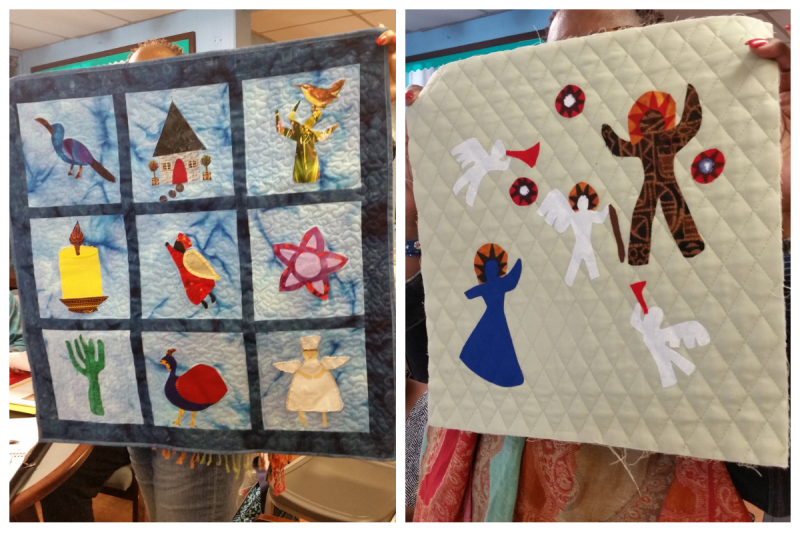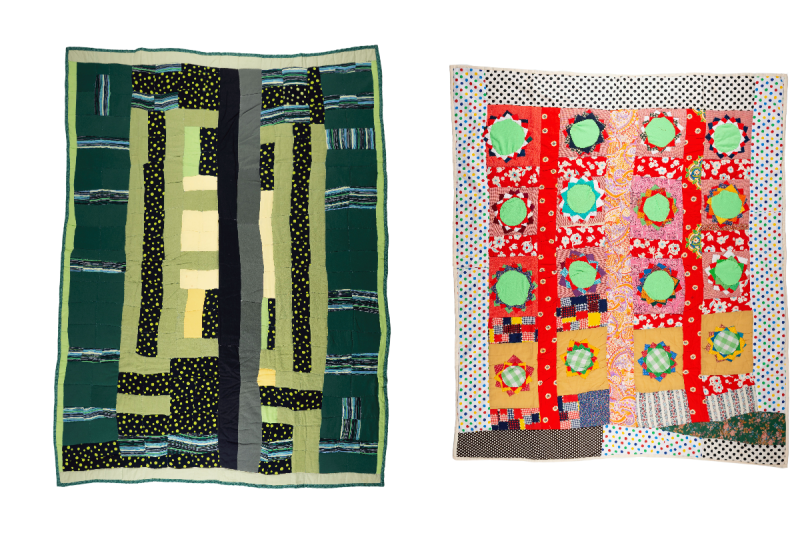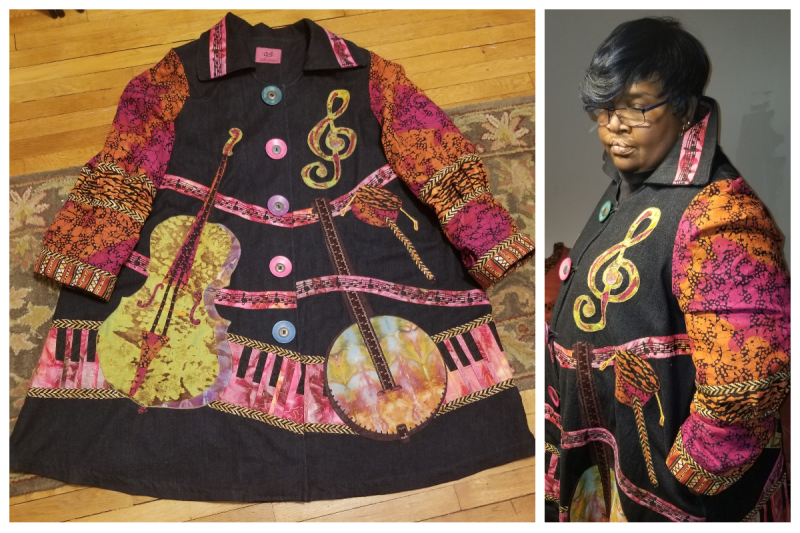Black American culture can be understood as an interwoven tapestry of dialects, foodways, spiritual systems, and community-based customs that have endured for hundreds of years. Like jazz, hip-hop, and soul food, quilting is one of the many art forms emerging from this rich heritage. For generations, the patterned blankets have served as statement bedding in many Black American households, folded gently over the foot of the bed or as décor draped across the arm of a sitting room couch.
But quilts have served far more than the basic function of keeping people warm as they slept. For many, quilts are powerful works of art that have held the hopes and dreams of Black families for generations. And they’ve had a political purpose, too. Quilts were once used as covert weapons in Black Americans‘ fight for freedom — and as a historical record of victories won.
The history of quilting in Black American culture began as early as the 17th century, with enslaved women threading, sewing, and quilting together patchwork blankets made with scraps of fabric from slave owners’ households — purely for the purpose of keeping themselves and their families warm throughout the night. As they fostered a higher level of skill and craftsmanship, they began to view the quilts not only as bedding but as messengers that could be enlisted in their collective journey toward liberation. Similar to how seemingly benign Negro Spirituals like “Wade in the Water” were actually coded messages meant to guide people to freedom, quilts featured certain patterns to outline escape routes and mark places of refuge on the Underground Railroad. They became unspoken yet sophisticated mnemonic devices.

According to the African American Registry, a bow-tie pattern would tell enslaved people to dress in disguise and appear as though they were of higher status. A bear paw signaled the need to follow an animal trail to get food and water. A log cabin would signal safety — that they could seek shelter where they were. Homes, businesses, churches, and other sympathetic establishments would hang the quilts from windowsills or clotheslines as a way to speak the unspeakable, serving as symbols of hope and safety during one of the most tumultuous points of American history.
For generations since, quilting has been passed down as both a survival skill and a medium for cultural and artistic expression. Quilting, of course, is not exclusive to Black American culture, but the conditions under which it developed have given it a unique quality within the genre. Instead of being hindered by the affront of having to use scraps to make basic bedtime necessities, it spurred innovation and creativity, along with a determination to make something beautiful that might restore a stripped sense of dignity. This led to Black American quilters developing new styles and techniques. “String quilts,” for example, were known by the thin scraps of leftover fabric, which would be stitched together then sewn into a full quilt. Other patterns include the Nine Patch, Ocean Wave, Sawtooth, Railroad Crossing, Feathered Star, Tree of Paradise, and Drunkard’s Path.
Following the end of slavery, quilts became a beloved part of the cultural and familial landscape, serving as a way to deliver messages that were far less dire but just as important.

“My great-grandmother was the child of slaves and all the children grew up with quilts made by family members. They represented love, warmth, and most importantly, our lineage and history,” says fourth-generation quilter Benet Wilson, who can trace her family’s history of quilting back to the late 1800s. “It was an art form, but more importantly, it was a way to keep families warm and show your love for a family that could be torn apart at any time.” Many quilts were used as canvases to display family trees, dramatic tales of biblical bravery, tranquil snapshots of daily life, and local histories that remain relevant today.
Wilson’s love and appreciation for the inherited art form deepened when she saw an exhibit by the Gee's Bend quilters at Houston’s Museum of Fine Arts in 2002. Gee’s Bend, Alabama, home to many direct descendants of American chattel slavery, is known for upholding the tradition of quilting while simultaneously advancing it with abstract and conceptual designs. According to Black Art in America, quilts by Black women have evolved into a means of exploring broader themes like sisterhood, female empowerment, and Black feminine beauty. This artistic expansion helped solidify quilting as a bona fide medium in the world of high art, as quilts were once marginalized as a low-skill craft practiced mainly by women and folk-artists.

Artists like Faith Ringgold, author of the award-winning children’s book “Tar Beach” and the renowned quilting project Tar Beach 2, have served as emissaries, portraying critically acclaimed scenes that infuse political statements about Black childhood with the magic of being a kid. Today, younger designers are taking the genre even farther. Fiber artist Bisa Butler is credited with transforming the medium with stunning portrait quilts that look like paintings. Her work has been featured in the Smithsonian National Museum of African American History and Culture, the Art Institute of Chicago, the Epcot Center, and more. She was also commissioned to quilt cover images for Time Magazine’s “Person of the Year” and its “100 Women of the Year” issues in 2020.
In addition to quilting’s history of resistance and cultural pride, the practice has also been used for positive mental health practices. It is a calming and soothing activity that some employ as a way to center themselves or quiet a racing mind before bed.

Carolyn Davis, a fourth-generation quilter from New Jersey serves as president of the Nubian Heritage Quilters Guild, founded in 1995 to document and preserve the culture of quilting. She attests that quilting gives her peace of mind.
“[Quilting] gives me joy — especially when I finish a piece,” Davis says. “But my designing stage is more important to me than actually doing it. The creation of designs in my mind or on my notebook just brings me joy, and that translates into a great peace of mind.”
For many Black people, positive mental health practices, along with rest, can be seen as additional forms of resistance. It’s a way to assert agency over their own bodies, divorce themselves from the trauma of being overworked, and reclaim a sense of humanity. In Glendora Simonson’s home, quilting is not just a pastime that she has taught for nearly 30 years, but also a form of comfort.
“Everybody has a quilt, and my children would have their own quilts growing up. I also have decorative pieces that go on the walls of my home,” Simonson says. “But I also found quilting jackets is something I enjoy, as it still tells the stories I want to tell.”

Both Davis and Simonson, who are also mentor and protégé, have spent many years teaching and introducing quilting to people of varying ages, imparting the importance of sharing history through art.
“I’m hoping that I can position my quilts in places where they can be appreciated,” Simonson says. “We are not just copying traditional ideas but we are influencing the color palettes, the storytelling, and the political statements because what’s important to us in being reflected in our quilts.”
As new generations pick up the craft and add their take to the tapestry, the stories and artistry of Black American quilters will continue to wrap us up in their warmth and embrace.
For a list of Black quilters guilds nationwide, visit the Nubian Heritage Quilters Guild site. Additionally, scheduled exhibits of contemporary quilting and textile collections by Black artists can be found at the Souls Grown Deep site.
Select quilts from the Gee's Bend quilters will also be on display through May 8, 2022 at the Blanton Museum of Art at the University of Texas at Austin, for the exhibit Assembly: New Acquisitions by Contemporary Black Artists.






